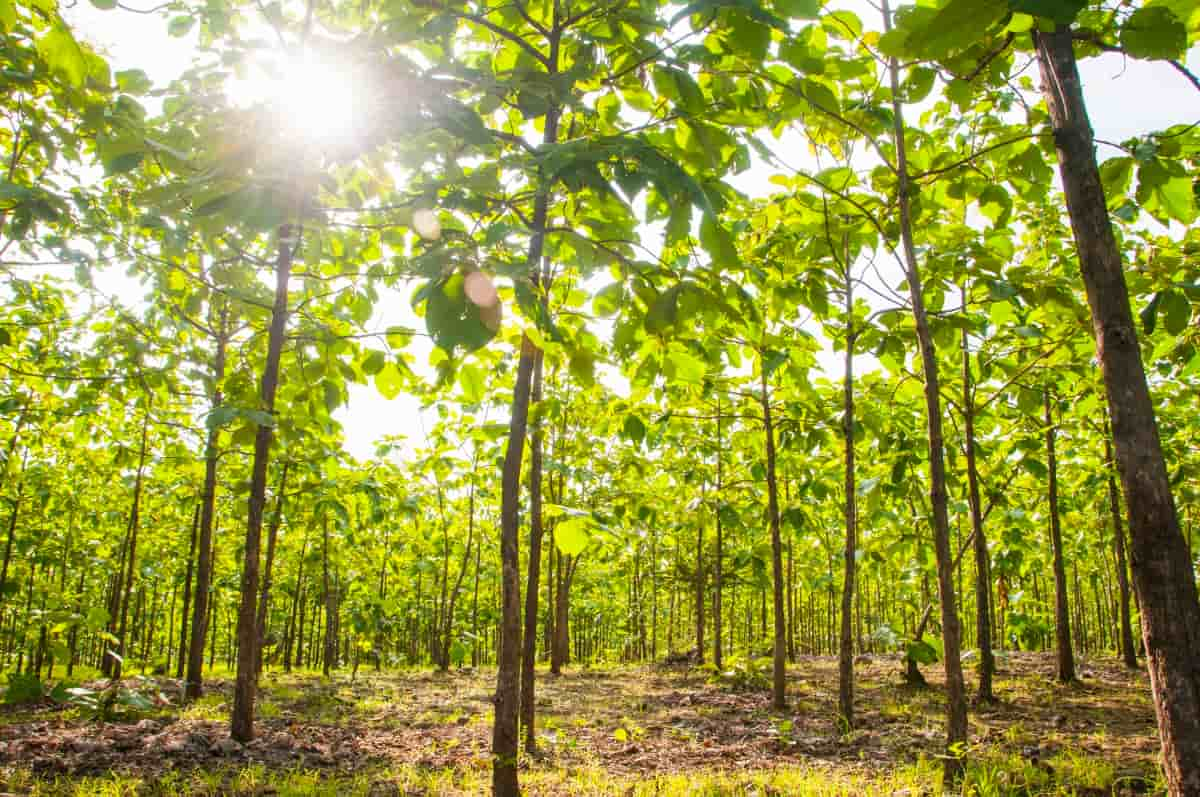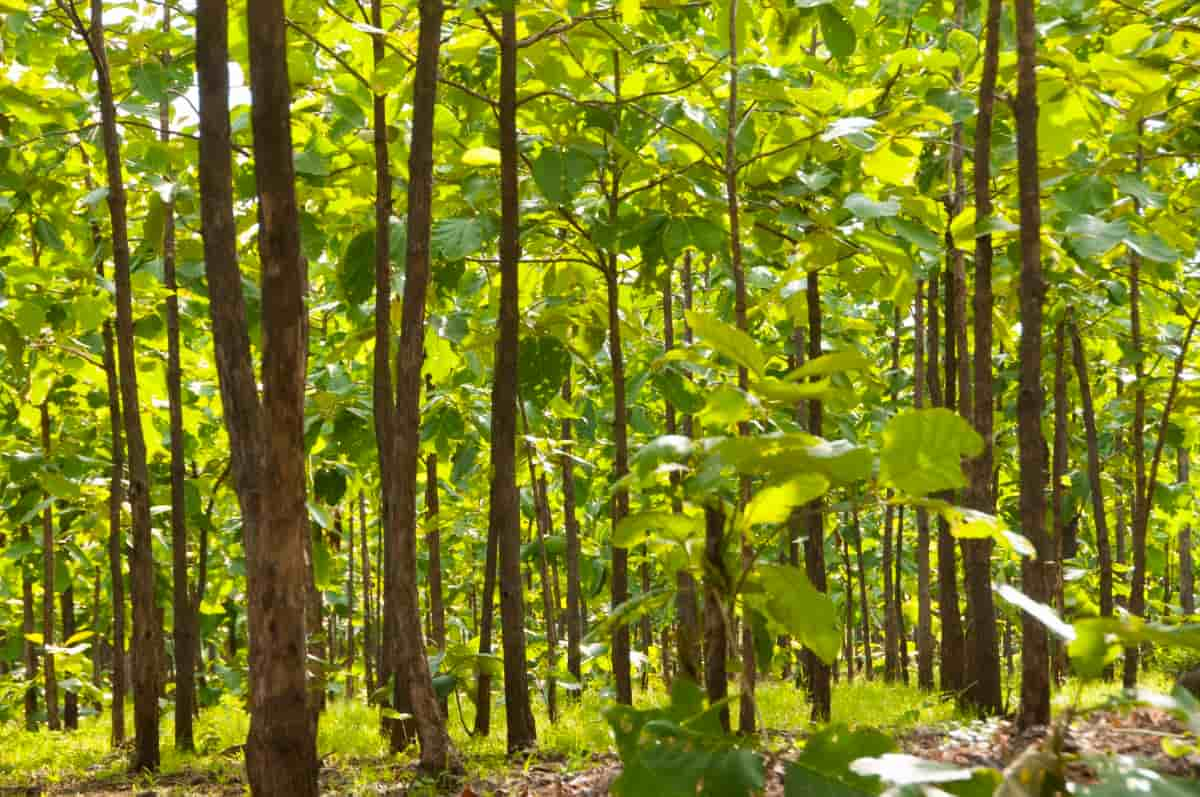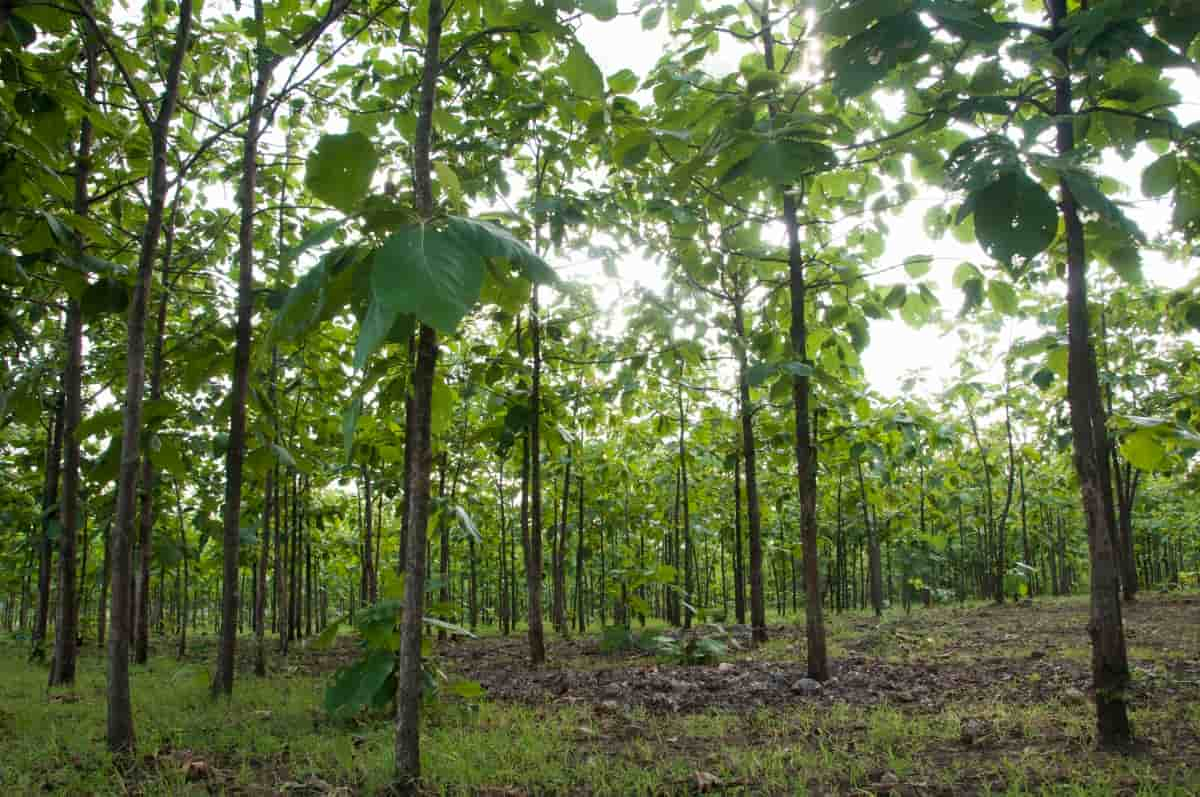Teakwood, renowned for its durability and aesthetic appeal, holds significant value in the global timber market. Cultivating teak requires a nuanced understanding of the species and effective plantation practices. This article delves into the comprehensive cultivation practices of teakwood plantations, aiming to guide enthusiasts and commercial growers alike.

From selecting optimal planting sites and soil preparation to addressing pest management and growth-enhancing techniques, we explore the intricacies of teak cultivation. By delving into the various aspects of teakwood plantation, this guide intends to equip readers with the knowledge necessary to foster healthy teak trees, ensure sustainable yields, and contribute to the flourishing world of timber cultivation.
Cultivation Practices of Teakwood
Select the Right Location for Teakwood Plantation
Choosing the right location for a teakwood plantation is crucial for optimal growth and yield. Teak (Tectona grandis) thrives in tropical climates with well-defined wet and dry seasons. Ideally, select a site with deep, well-drained soil that is rich in organic matter. The teak is sensitive to waterlogging, so ensure good drainage to prevent root rot. The plantation should be situated in an area with an annual rainfall of 1,200-2,500 mm, evenly distributed throughout the year, to support the teak’s growth.
A temperature range of 20-40°C is suitable for teak cultivation. Additionally, teak requires abundant sunlight for photosynthesis, so choose a location with ample sunlight exposure. Consider factors such as altitude, slope, and wind exposure. Teakwood plantations are often successful in elevations ranging from 300 to 1,500 meters. A gentle slope aids in water runoff, preventing waterlogging, while windbreaks can protect young teak saplings.
Soil Preparation and Management for Teakwood Cultivation
Begin by conducting a soil test to assess its composition and nutrient levels. Teak thrives in well-drained soils with a pH ranging from 6.5 to 7.5. Amend the soil with organic matter, such as vermicompost or well-rotted manure, to enhance fertility and structure. Implement proper land preparation techniques, including plowing and harrowing, to ensure a loose and aerated soil profile.
This aids in root development and water infiltration. Implement contour plowing on slopes to prevent soil erosion. Consider incorporating a balanced fertilizer based on soil test results to meet teak’s nutrient requirements. Regular inspecting and adjustment of nutrient levels are essential for healthy growth.
Seed Selection and Propagation Techniques for Teakwood
Selecting quality teak seeds and employing effective propagation techniques are essential for successful teakwood cultivation. Choose seeds from healthy, mature teak trees with desirable traits such as straight boles and disease resistance. Conduct a germination test to ensure seed viability. Direct seeding in well-prepared seedbeds is a common practice, with seeds sown at the beginning of the rainy season. Pre-soaking seeds for 12-24 hours can enhance germination.
Planting and Spacing Guidelines for Teakwood Trees
When planting teakwood trees, follow specific guidelines for optimal growth and yield. Plant teak saplings at a spacing of 3 meters by 3 meters for a dense plantation, promoting straight boles and limiting branch development. Ensure proper site preparation, including soil enrichment and weed control.
In case you missed it: How to Grow Agarwood Tree from Seeds: Planting, Spacing, Pruning, Fertilizing, and Yield

Dig holes double the size of the root ball to facilitate root expansion. Plant the saplings at the same depth as they were in the nursery, water thoroughly, and mulch to retain soil moisture. Implement regular pruning to shape the trees and remove low-quality wood. Adjust spacing based on management objectives, allowing flexibility for thinning operations as the trees mature.
Number of Teakwood Plants Per Acre
The number of teakwood plants per acre depends on the desired planting spacing. For a standard spacing of 2 meters by 2 meters (approximately 2,722 plants per hectare), you would plant about 1000 teakwood plants per acre. Adjustments can be made based on management objectives, growth expectations, and local conditions.
Some plantations may opt for wider spacing, reducing the number of plants per acre to allow for broader canopy development and easier management practices. Conversely, narrower spacing increases tree density, potentially maximizing timber yield but requiring more intensive management.
Irrigation and Water Management in Teakwood Plantations
Teakwood plantations benefit from strategic irrigation and water management practices to ensure optimal growth. In regions with insufficient rainfall, supplemental irrigation during dry periods is crucial, especially during the initial years of plantation establishment. Drip irrigation systems are effective in delivering water directly to the root zone, minimizing water wastage. Implement water conservation techniques, such as mulching, to retain soil moisture. Additionally, monitor soil moisture levels regularly to adjust irrigation schedules accordingly.
Nutrient Management and Fertilization for Teakwood Growth
Effective nutrient management is essential for optimal teakwood growth. Conduct soil tests to assess nutrient levels and pH. Teak thrives in well-drained soils with a pH of 6.5 to 7.5. Implement a balanced fertilization program based on soil deficiencies, typically incorporating nitrogen, phosphorus, and potassium.
Apply organic amendments like compost for sustained nutrient release. Regularly monitor nutrient levels and adjust fertilizer applications accordingly. Avoid excessive nitrogen in later stages to promote heartwood formation. A well-managed nutrient program ensures vigorous teak growth, wood quality, and overall plantation productivity.
Weed Control Strategies in Teakwood Plantations
Effective weed control is crucial in teakwood plantations to reduce competition for nutrients and promote tree growth. Utilize mulching around teak saplings to suppress weed growth and retain soil moisture. Implement pre-emergence herbicides before planting to inhibit weed germination. Mechanical methods like manual weeding or mowing can be employed in combination with herbicides. Regular monitoring and timely intervention are key to maintaining a weed-free environment and supporting healthy teakwood development.
In case you missed it: Benefits of Wood Ash for Your Garden Plants: How to Apply and When to Use Wood Ash as Fertilizer

Pest and Disease Management in Teakwood Cultivation
Pest and disease management is vital for successful teakwood cultivation. Common pests include defoliators and borers, while diseases like leaf spot and rust can affect teak trees. Implement integrated pest management strategies, combining biological control, cultural practices, and judicious use of pesticides. Regular monitoring helps detect issues early. Prune and remove affected branches to control the spread of diseases.
Promote natural predators and beneficial organisms to control pest populations. Maintain proper spacing for air circulation and sunlight penetration, reducing disease incidence. Healthy soil practices and balanced nutrition contribute to pest and disease resistance, ensuring sustainable teakwood plantation management.
Pruning and Thinning Practices for Teakwood Trees
Pruning and thinning are essential practices in teakwood plantation management. Prune young teak trees to encourage a single dominant stem, reducing the formation of low-quality branches. Regular pruning enhances tree form and timber quality. Thinning, the selective removal of trees should be carried out as the plantation matures to reduce competition for resources and achieve optimal spacing. Proper thinning enhances individual tree growth and timber yield while ensuring a healthy and sustainable teakwood stand.
Harvesting and Post-Harvest Handling of Teakwood
Teakwood harvesting involves selective felling of mature trees, typically around 20-30 years old, for optimal heartwood development. Harvesting during the dry season minimizes moisture content in the wood. Employ appropriate cutting techniques to ensure the desired log quality. Post-harvest, transport logs carefully to prevent damage.
Milling should follow promptly to minimize wood degradation. Proper drying techniques, such as air-drying or kiln drying, are crucial to achieve the desired moisture content for durability. Implementing careful harvesting and post-harvest handling practices is essential for obtaining high-quality teakwood products with desirable characteristics for various applications.
The Yield of Teakwood Per Acre
Teakwood yield per acre varies based on factors like planting density, growth conditions, and management practices. Under optimal conditions with a spacing of 2 meters by 2 meters, a well-managed teakwood plantation may yield around 200-400 cubic feet of wood per acre at the age of 20-30 years. However, yield can significantly differ, and periodic thinning may influence the final volume and quality of harvested teakwood. Successful management practices contribute to maximizing the yield potential of teak plantations.
In case you missed it: Types of Organic Fertilizers and How They Help Plants Grow

Conclusion
In conclusion, successful teakwood cultivation requires meticulous attention to various practices. From careful site selection, soil preparation, and nutrient management to strategic irrigation, pest control, and post-harvest handling, each step plays a vital role. Implementing these practices ensures healthy growth, sustainable yields, and the production of high-quality teakwood for diverse applications.
- Feed Your Flock for Less: Top 10 Tips to Save on Chicken Feed
- Ultimate Guide to Ossabaw Island Hog: Breeding, Raising, Diet, and Care
- Hatching Answers: The Top 10 Reasons Your Chickens Aren’t Laying Eggs
- Eggs and Economics: Breaking Down the Cost of Raising Backyard Chickens
- Defend Your Greens: Proven Methods to Keep Iguanas Out of Your Garden
- Ultimate Guide to Cinnamon Queen Chicken: A Comprehensive Guide for Beginners
- Ultimate Guide to California Tan Chicken: Breeding, Raising, Diet, Egg-Production and Care
- Ultimate Guide to Marsh Daisy Chicken: Breeding, Raising, Diet, and Care
- 10 Types of Chicken Farming Businesses You Can Start for Profits